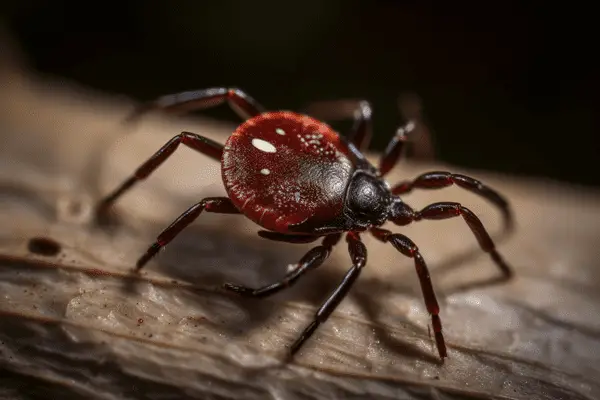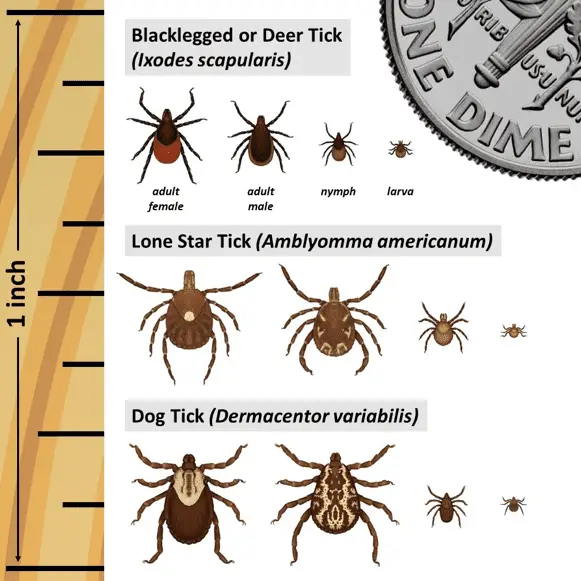One of the few downsides to camping is that your exposure to ticks can go way up. This is especially true for people who live in the city where they’re unlikely to ever be exposed to ticks and tick-borne illnesses.

So what can you do? How can you avoid ticks while camping?
Here are 7 simple ways to avoid ticks when camping:
Wear The Right Clothing
The best way to avoid ticks when camping is to wear the right clothing. Protective clothing will help keep ticks away from your skin without the need for potentially dangerous poisons.
Dress in long-sleeved shirts, long pants, and closed-toe shoes. Tuck your pants into your socks and your shirt into your pants to create a physical barrier against ticks.
The clothing you wear should also be in light colors. This will make it easier to spot ticks on your clothing before they have a chance to attach to your skin.
Treat Your Clothing and Gear
Treat clothing and gear with permethrin. Permethrin is an insecticide that can be applied to clothing, tents, and other gear to repel and kill ticks. Many campers, hikers, and hunters swear by permethrin treated clothing while others prefer to avoid it.
Here are some pro’s and cons to using permethrin.
Pros:
- Effective tick repellent: Permethrin-treated clothing is highly effective in repelling and killing ticks, reducing the risk of tick-borne diseases.
- Long-lasting protection: Permethrin bonds to fabric fibers, providing protection for several weeks or multiple washings, depending on the product.
- Broad-spectrum protection: In addition to ticks, permethrin is effective against mosquitoes, chiggers, and other biting insects, providing comprehensive protection during outdoor activities.
- Safe for humans and pets: When used as directed, permethrin is considered safe for humans and pets, with minimal risk of adverse reactions.
Cons:
- Not suitable for direct skin application: Permethrin is intended for use on clothing and gear, not for direct application to skin, which requires the use of a separate insect repellent.
- Toxic to aquatic life and cats: Permethrin is highly toxic to fish, aquatic organisms, and cats. Care must be taken to avoid contaminating water sources or exposing cats to treated items.
- Odor and residue: Some users may notice a slight odor or residue on treated clothing, which can be off-putting.
- Cost: Regularly treating clothing and gear with permethrin can add an additional expense to your outdoor activities.
Choose The Right Campsite
Some campsites are more prone to ticks than others. Here are some tips you can use to choose a campsite that’s less likely to have ticks in it.
- Select an open area: Opt for a campsite with short grass, minimal brush, and good sunlight exposure. Ticks thrive in moist, shady environments, so an open, sunny area will be less hospitable to them.
- Avoid wooded edges: Ticks are often found along the edges of wooded areas, where the forest meets grassy clearings. Choose a campsite that is farther away from these transitional zones.
- Stay on established paths: Stick to well-trodden paths and camping areas that have been cleared of vegetation. These areas are less likely to harbor ticks than undisturbed areas with tall grass and leaf litter.
- Look for well-maintained campsites: Choose campsites that are regularly maintained, as proper upkeep can reduce tick populations. Campsites with trimmed grass, raked leaves, and minimal brush are less likely to have high tick populations.
- Check for tick activity: Before setting up camp, survey the area for any signs of tick activity. This can include inspecting the ground, vegetation, and any nearby animal burrows or nests.
- Avoid areas with high deer populations: Ticks often feed on deer, so camping in areas with high deer populations can increase your risk of encountering ticks. Look for campsites that are not located near known deer habitats or trails.
- Camp above ground: If possible, use a tent with a built-in floor or a hammock with mosquito netting to sleep above the ground. This will reduce the chances of ticks crawling into your sleeping area.
Keep Your Campsite Clean
One of the main reasons to keep a campsite clean to avoid ticks is that doing so reduces their preferred habitat. Regular upkeep of the camping area, such as trimming the grass, raking leaves, and removing brush, makes the environment less hospitable for ticks. This, in turn, decreases the chances of encountering them while camping. Furthermore, a clean campsite is less likely to attract animals, like deer or rodents, which can carry ticks and inadvertently introduce them into your camping area.
To keep a campsite clean and minimize tick exposure, follow these three steps:
- Clear away vegetation: Remove tall grass, brush, and leaf litter around your campsite. This will reduce the places where ticks can hide and thrive. Make sure to maintain a clear perimeter around your tent, dining, and relaxation areas.
- Store gear off the ground: Keep your gear, including backpacks and clothing, off the ground and away from vegetation to minimize contact with ticks. Use tables, benches, or hang your belongings from trees to reduce the chance of ticks finding their way onto your possessions.
- Dispose of trash properly: Clean up food scraps, trash, and other waste promptly and store it in sealed containers or designated trash receptacles. This will help to avoid attracting animals that may carry ticks.
One thing to note when cleaning up your campsite is that you don’t want to harm the natural environment. Please keep “no trace left behind” guidelines in mind when clearing away or removing vegetation.
Use Insect Repellent
Insect repellents are an effective way to protect yourself from ticks and the diseases they can transmit. There are various types of repellents available, each with different active ingredients that are effective against ticks.
Here are some of the most commonly used tick repellents:
| Insect Repellent | Active Ingredient | Concentration Range | Advantages | Disadvantages |
|---|---|---|---|---|
| DEET | N,N-Diethyl-meta-toluamide (DEET) | 10% – 100% | Widely recognized, highly effective, long-lasting | Can cause skin irritation, has an odor |
| Picaridin | Icaridin (Picaridin) | 5% – 20% | As effective as DEET, odorless, less skin irritation | Requires at least 20% for tick protection |
| IR3535 | Ethyl butylacetylaminopropionate | 10% – 20% | Effective, less skin irritation than DEET | Less well-known |
| OLE and PMD | Oil of lemon eucalyptus, para-menthane-3,8-diol | N/A | Plant-based, effective against ticks and mosquitoes | Not as long-lasting as DEET or Picaridin |
Want to learn more about these repellants? Follow the links below:
http://npic.orst.edu/factsheets/PicaridinGen.html
https://www.cdc.gov/malaria/toolkit/deet.pdf
https://pubchem.ncbi.nlm.nih.gov/compound/Ethyl-butylacetylaminopropionate
https://www3.epa.gov/pesticides/chem_search/reg_actions/registration/fs_PC-011550_01-Apr-00.pdf
Perform Regular Tick Checks
Performing regular tick checks while camping is essential for early detection and removal of ticks, which can help prevent the transmission of tick-borne diseases. Ticks often attach themselves to their hosts and feed on their blood for extended periods, during which they can transmit pathogens that cause diseases like Lyme disease, Rocky Mountain spotted fever, and Anaplasmosis. The sooner a tick is found and removed, the lower the risk of disease transmission, as some pathogens take several hours or even days to be transmitted from the tick to the host.

Graphic courtesy of https://www.nps.gov/dewa/planyourvisit/tick-safety.htm
To perform a tick check, carefully inspect your body and clothing for any ticks, paying close attention to areas where ticks are more likely to attach. These areas include the armpits, groin, waist, behind the ears, the back of the knees, and around the hairline. Use a mirror or ask a friend to help check hard-to-see areas. It’s a good idea to perform tick checks every few hours while outdoors, as well as at the end of each day spent camping.
In addition to checking your own body, inspect your clothing and gear for ticks. Ticks can cling to clothing and backpacks, making their way onto your skin later. Shake out your clothes and belongings, and if you have access to a clothes dryer, dry your clothes on high heat for at least one hour to kill any remaining ticks.
Don’t forget to check your pets for ticks as well. Ticks can easily latch onto pets and be brought into your tent or vehicle, potentially posing a risk to both the pet and you. Pay close attention to their ears, around their eyes, and between their toes, as these are common hiding spots for ticks.
Incorporating regular tick checks into your camping routine is a crucial preventive measure to protect yourself, your companions, and your pets from the risks associated with tick-borne diseases. Being vigilant and promptly removing any ticks found can significantly reduce the chances of infection and help ensure a safe and enjoyable camping experience.
Wash And Dry Your Clothing
Unfortunately, detergents like borax won’t kill ticks the way they kill ants and cockroaches. Instead, you’ll have to use the actual machine washing process to kill them. Additionally, ticks can survive a regular wash cycle, so be sure to wash your clothes in hot water and dry them on high heat for at least one hour to kill any remaining ticks.
Personally, I take advantage of my bright camping clothing and do an inspection on my clothing before I even bring it into the house. I’ll then use a pair of tweezers to take the ticks off and drop them into a jar full of rubbing alcohol. Rubbing alcohol kills and preserves ticks, which might be useful if you need to get the ticks tested for disease.
What To Do if a Tick Gets on You?
If you find ticks on you while camping, don’t panic. Just because you got a tick on you, doesn’t mean you have to end your camping trip. This being said, you should safely remove the tick as soon as possible. Doing so will reduce the risk of tick-borne diseases.
Here’s how to do it:
- Remove the tick: Use a pair of fine-tipped tweezers or a specialized tick removal tool to grasp the tick as close to the skin’s surface as possible. Gently but firmly pull the tick straight up and out, taking care not to twist or crush it. Avoid using your fingers, as this can increase the risk of disease transmission.
- Clean the area: Once the tick has been removed, thoroughly clean the bite area with soap and water, rubbing alcohol, or an antiseptic wipe. This helps prevent infection and ensures that any remaining tick parts or bacteria are cleaned away.
- Dispose of the tick: Place the removed tick in a sealed plastic bag or container, or submerge it in rubbing alcohol to kill it. Do not crush the tick with your fingers, as this can release bacteria and increase the risk of infection.
- Monitor for symptoms: Keep an eye out for any signs of tick-borne diseases in the days and weeks following the tick bite. Symptoms can include fever, chills, muscle aches, fatigue, and a rash, among others. If you experience any of these symptoms, consult a healthcare professional and inform them of your recent tick exposure.
- Document the incident: Take note of the date and location of the tick bite, as well as any identifying features of the tick, such as size and color. This information can be helpful for medical professionals in case you develop symptoms later on.
Once you’re done removing the tick, you may want to do another tick-check on yourself and the people you’re camping with. This may also be a good time to re-apply any insecticides you brought with you and to double-check to make sure your campsite is as clean as it can be.
Know any other good ways to avoid ticks while camping? Comment below!
